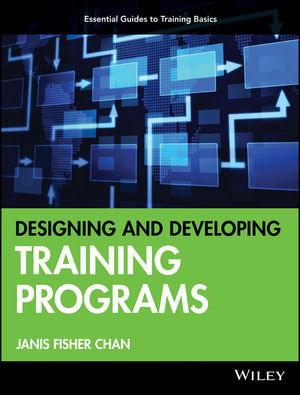Designing and Developing Training Programs: Pfeiffer Essential Guides to Training BasicsISBN: 978-0-470-40469-0
Paperback
304 pages
December 2009, Pfeiffer
 This is a Print-on-Demand title. It will be printed specifically to fill your order. Please allow an additional 10-15 days delivery time. The book is not returnable.
|
||||||
1. THE TRAINING PLAN.
1. Why You Need a Plan.
2. Planning Instructional Programs.
3. What to Consider When Using ADDIE.
What's Next?
2. ANALYZING THE SITUATION.
1. What's a Needs Assessment?
2. Gathering Information.
3. Analyzing the Information.
4. Consider the Stakeholders.
5. Consider the Learners.
6. Identifying Constraints and Other Factors That Impact the Training Program Design.
7. Determine Who Should Be Involved in Designing the Training Program.
8. Design It or Buy It?
What's Next?
3. WRITING LEARNING OBJECTIVES.
1. Why Learning Objectives Matter.
2. What a Learning Objective Should Be.
3. What Makes a Learning Objective Useful?
4. How to Develop Learning Objectives.
5. Enabling Objectives.
What's Next?
4. CHOOSING THE DELIVERY METHOD.
1. Overview of Training Delivery Methods.
2. Characteristics of Common Delivery Methods.
3. How to Choose a Delivery Method.
What's Next?
5. IDENTIFYING CONTENT.
1. A Learner-Centered Approach to Content.
2. Nice-to-Know vs. Must-Know Content.
3. How to Identify Content.
What's Next?
6. PLANNING THE LEARNING ACTIVITIES.
1. What to Consider About Activities.
2. Components of an Experiential Learning Activity.
3. Types of Activities.
What's Next?
7. STRUCTURING A TRAINING PROGRAM.
1. What's Involved in Structuring a Training Program.
2. Determining the Sequence.
4. Planning the Opening and the Closing.
5. Checking the Timing.
6. Identifying Visuals, Media, and Training Aids.
7. Preparing a Preliminary Agenda.
What's Next?
8. DEVELOPING MATERIALS AND VALIDATING THE PROGRAM.
1. Using a Training Materials Work Plan.
2. Developing Participant Materials.
3. Developing Trainer Materials.
4. Developing the Slides
5. Identifying Materials for Activities.
6. Validating the Training Program.
What's Next?
9. EVALUATING THE RESULTS.
1. The Function of Evaluation.
2. Questions an Evaluation Needs to Answer.
3. How to Conduct an Evaluation.
What's Next?
10. DESIGNING DISTANCE LEARNING PROGRAMS.
1. Overview of Distance Learning Programs.
2. Deciding When and How to Use Distance Learning.
3. Design Principles for Virtual and Remote Training Programs.
Resources.
About the Author.



